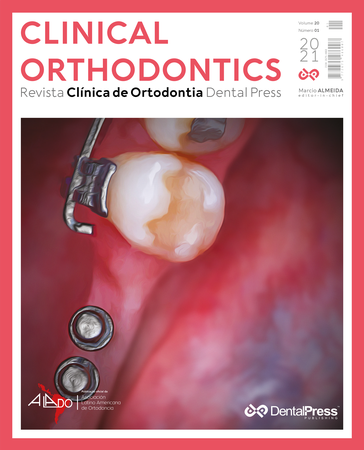Editorial Board
Autores: Marcio Rodrigues de Almeida,
messages.RevistaAutores:
LEIA MAIS
Directions and trends of Orthodontics in 2021
In this first volume of 2021, I thought I would reflect on what we could expect from the new directions of orthodontics, since 20201 was not easy for anyone. I admit I was more excited when we were preparing the last edition of the year. If you remember, the cover of issue 19(6), released in...
Autores: Marcio Rodrigues de Almeida,
messages.RevistaAutores:
LEIA MAIS
An interview with Cauby Maia Chaves Junior
Professor Cauby Maia Chaves Jr. is completing 30 years as a dental surgeon; of these, at least 26 were dedicated to two passions that have guided his professional life: Orthodontics and Sleep Medicine. Graduated at the Federal University of Ceará (UFC), he recently became the first Full Professor...
Autores: Cauby Maia Chaves Júnior, Cibele Dal-Fabbro, Lia Rita Azeredo Bittencourt, Bruno Furquim, Rowdley Rossi,
messages.RevistaAutores: entrevista,
LEIA MAIS
The biomechanics of correction of unilateral dental crossbite
INTRODUCTION: The treatment of unilateral crossbite offers some challenges to the orthodontist. OBJECTIVE: The present article proposes to diagram, explain and exemplify, by means of a clinical case, the use of the differential pressure technique applied to the periodontal ligament for the...
Autores: Renato Parsekian Martins,
messages.RevistaAutores: Biomechanics, Palatal bar, Orthodontic archwires,
LEIA MAIS
The importance of the immediate anterior guidance: part 1
INTRODUCTION: The anterior guidance is one of the most important goals in orthodontics, related to functional occlusion, vertical treatment stability and labial esthetics. OBJECTIVE: The present article aims to demonstrate, by means of examples, the importance of the anterior guidance in the...
Autores: Marcos Janson,
messages.RevistaAutores: Orthodontic stability, Anterior guidance, Functional occlusion,
LEIA MAIS
Vertical mini-implants on the alveolar ridge: creating orthodontic anchorage in cases of multiple tooth loss
OBJECTIVE: To describe a technique with the use of vertical mini-implants in the alveolar ridge of edentulous areas, to provide an adequate orthodontic anchorage. CONCLUSIONS: The approach described herein can facilitate the orthodontic preparation prior to the prosthetic rehabilitation of adult...
Autores: Daniel Santos Fonseca Figueiredo,
messages.RevistaAutores: Orthodontic Anchorage Procedures, Orthodontics, corrective, Jaw, partially edentulous,
LEIA MAIS
Vertical Z-bend
Autores: Marden Bastos,
messages.RevistaAutores: Dicas,
LEIA MAIS
Mini-Hyrax expander: a versatile alternative for rapid maxillary expansion
OBJECTIVE: The aim of this article is to illustrate the applicability of the Mini-Hyrax expander for rapid palatal expansion (RPE) and surgically-assisted rapid palatal expansion (SARPE). APPLIANCE DESCRIPTION: The major differences between the expander screw used in the Mini-Hyrax expander and the...
Autores: Giordani Santos Silveira, Dauro Douglas Oliveira, Paulo Isaias Seraidarian, Amanda Rafaela Diniz, Ana Luiza Cabral de Ávila Andrade,
messages.RevistaAutores: Palatal Expansion Technique, Permanent dentition, Primary dentition, Crossbite,
LEIA MAIS
Use of miniscrews in the buccal shelf for mandibular molar mesialization - Part 2
INTRODUCTION: Bodily mesialization of the mandibular molar is frequently performed in the orthodontic clinic, due to agenesis and premature loss of molars or premolars. However, this orthodontic movement is difficult to perform due to the need to control rotation, angulation and the torque on these...
Autores: Henrique Mascarenhas Villela, Anastácio Barbosa Braga,
messages.RevistaAutores: Buccal Shelf, Miniscrew, Mini-implants, Molar mesialization,
LEIA MAIS
Orthodontic space opening in the posterior region of the dental arch during mixed dentition: Case report
OBJECTIVE: Premature loss of posterior deciduous teeth is very common and interferes with the chronology and sequence of dental eruption, leading to malocclusions like the deficiency of arch space for correct dental alignment and interference with tooth eruption chronology. Thus, the dentist...
Autores: Maria Bernadete Sasso Stuani, Paôla Caroline da Silva Mira, Marina Andrade Lemos, Wendes Dias Mendes, Maria Cecília Gorita dos Santos, Murilo Andrade Lemos, Valéria Oliveira Pagnano,
messages.RevistaAutores: Orthodontics, interceptive, Dentition, mixed, Orthodontic appliances, removable,
LEIA MAIS
Dentoalveolar anterior open bite treatment with digital indirect bonding: case report
INTRODUCTION: Open bite is a malocclusion of great aesthetic-functional impairment and may be dentoalveolar or even present skeletal involvement, which requires a correct diagnosis for proper clinical management. It is a complex malocclusion mainly in relation to stability; therefore,...
Autores: Taís De Morais Alves Da Cunha, Inessa Da Silva Barbosa, Sérgio Freitas Ribeiro, Rodrigo Ferreira Carvalho, Karolinne Kaila Palma, Gabriel Carlos Fonseca Vilas Boas,
messages.RevistaAutores: Open bite, Orthodontics, corrective, Printing, three-dimensional,
LEIA MAIS
Interceptive treatment of severe Class II malocclusion with Thurow appliance
INTRODUCTION: Open bite is a maINTRODUCTION: Thurow maxillary splint, or Thurow appliance, is a maxillary splint associated to a high traction, effective in Angle Class II Division 1 correction, resulting in both anteroposterior and vertical changes. Objective: This case report reviews Thurow...
Autores: Telma Martins De Araújo, Antônio Carlos De Oliveira Ruellas, Luciana Duarte Caldas, Anna Paula Nigri,
messages.RevistaAutores: Malocclusion, Angle Class II, Extraoral traction appliances, Child,
LEIA MAIS
Why is it called the “Ugly Duckling” phase and does it self-resolve?
OBJECTIVE: To conceptualize and explain the “ugly duckling” phase, and explain why dental resorptions do not happen on the teeth involved. RESULTS: A comparison of the old ways of explaining the correction and self-correction of this phase was made with the current foundations. The maxillary...
Autores: Alberto Consolaro,
messages.RevistaAutores: Dental resorption, Growth vector, Canine, Eruption,
LEIA MAIS
Treatment of anterior open bite in a patient with Angle Class II malocclusion, atypical tongue posture and mouth breathing
INTRODUCTION: Occasionally, due to deleterious habits, the anterior open bite may persist even after the removal of the primary etiological factor, due to the atypical positioning of the tongue, which makes this malocclusion very recurrent. CASE REPORT: The present article reports the clinical...
Autores: Daniela Feu,
messages.RevistaAutores: Open bite, Class II malocclusion, Mouth breathing,
LEIA MAIS









.png)
